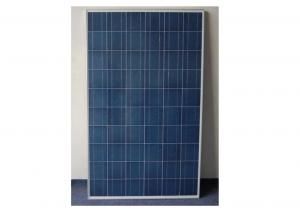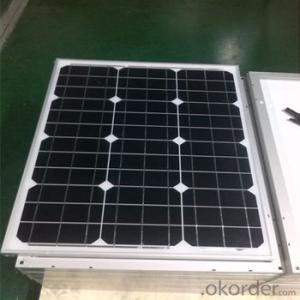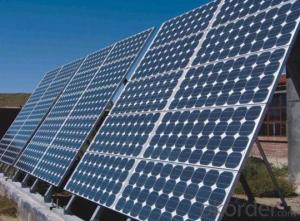Poly Solar Panels CNBM (250W-260W)
- Loading Port:
- China Main Port
- Payment Terms:
- TT or LC
- Min Order Qty:
- 1 pc watt
- Supply Capability:
- 10000 pcs per month watt/month
OKorder Service Pledge
OKorder Financial Service
You Might Also Like
Introduction of Poly Solar Panels CNBM (250W-260W)
Poly Solar Panels CNBM (250W-260W) is designed for large electrical power requirements. It is the optimal choice for both on-grid and off-grid power systems. CNBM Solar panel offers high performance of power per square foot of solar array. Poly Solar Panels CNBM (250W-260W) of Monocrystalline silicon(c-Si): often made using the Czochralski process. Single-crystal wafer cells tend to be expensive, and because they are cut from cylindrical ingots, do not completely cover a square solar cell module without a substantial waste of refined silicon.If you have interest in Poly Solar Panels CNBM (250W-260W) ,please contact us!
Characteristics of Poly Solar Panels CNBM (250W-260W)
I.Solar Cell : High efficiency crystalline solar cell. Even if under the weak light, the solar module can produce maximum power output.
II.Tempered glass (toughened glass): Anti-reflecting coating and high transmission rate glass increase the power output and mechanical strength of solar module.
III.EVA and TPT: Using high quality EVA and TPT to prevent destroying and water.
IV.AI frame: Without screw, corner connection. 6 holes on the frame can be installed easily.
V.Junction box: Multi function junction box with water proof.
VI.Long lifetime: ≥25 years; Less power decrease.
VII.Good performance of preventing from atrocious weather such as wind and hails.
VIII.Resisting moisture and etching effectively, not effected by geology.
IX.The certificate issued by international authority: UL, TUV, IEC, VDE, CE.
Standard Test Conditions of Poly Solar Panels CNBM (250W-260W)
The opto-electrical specifications shown below are stabilized values being measured at Standard Test Conditions, Irradiance: 1000W/m2, Spectrum: AM1.5 at 25°C, The info below is subject to manufacturing tolerances. Where appropriate minutes of measurement are available and are used for the dimensioning of the installation.
Advantages of Poly Solar Panels CNBM (250W-260W)
• CNBM Solar performance guarantees for 25 years
• 10 years guarantee for workmanship
• Timeliness of delivery
• Quality Products certified (TÜV, UL, CE, VDE, ISO)
CNBM International Corporation's products including Monocrystalline Solar Panel, Polycrystalline Solar Panel have received and enjoyed famous reputation in many countries and regions in the world .As a solar panel manufacturer in China, we strive to provide our customers with excellent service, superior products and unmatched value.
Datasheet of Poly Solar Panels CNBM (250W-260W)
Characteristics of Poly solar panels CNBM (250W-260W) | |||
Max Power Voltage Vmp(V) | 30.1 | 30.2 | 30.4 |
Max Power Current Imp(A) | 8.32 | 8.44 | 8.55 |
Open Circuit Voltage Voc(V) | 37.5 | 37.6 | 37.7 |
Short Circuit Current Isc(A) | 8.87 | 8.99 | 9.10 |
Max Power Pm(W) | 250 | 255 | 260 |
Temperature Coefficient of Cells of Poly Solar Panels CNBM (250W-260W) | |
NOCT | 45℃ ± 2℃ |
Temperature Coeffucients of Isc (%/℃) | 0.0492 |
Temperature Coeffucients of Voc (%/℃) | -03374 |
Temperature Coeffucients of Voc (%/℃) | -0.4677 |
Mechanical Data of Poly Solar Panels CNBM (250W-260W) | |
Dimension | 1638 × 982 × 40 mm |
Weight | 19.5 kg |
No. of Cells and Connections | 60 (6 ×10) |
Tolerance | 0 ~ + 5 W |
Cell | Monocrystalline Cell 156 × 156 mm |
Packing | 720 Pcs/40ft(H) Container |
Limits of Poly Solar Panels CNBM (250W-260W) | |
Operating Temperature | -40℃ to +85℃ |
Storage Temperature | -40℃ to +85℃ |
Max System Voltage | 1000VDC(IEC) / 600VDC(UL) |
Guarantees of Poly Solar Panels CNBM (250W-260W) | |
Products Guarantee | 10 yrs free from defects in materials and workmanship |
Performance Guarantee | No less than 90% within 10yrs and no less than 80% within 25yrs |
Certificates | TUV(IEC61215&IEC61730),VDE(IEC61215&IEC61730),UL,CE |
IV Curve of Poly Solar Panels CNBM (250W-260W)
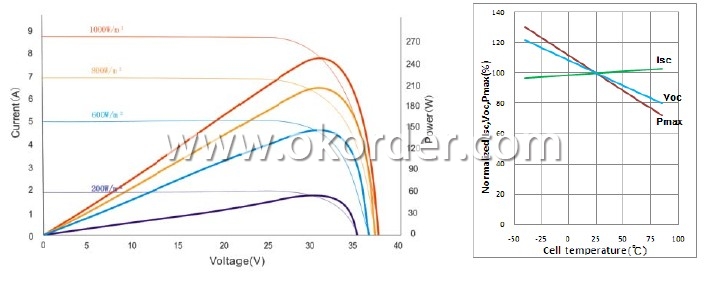
The data does not refer to a single module and it is not part of the offer
It is only for comparison only to different module types.
Test Conditions of Poly Solar Panels CNBM (250W-260W)
The opto-electrical specifications shown below are stabilized values being measured at Standard Test Conditions, Irradiance: 1000W/m2, Spectrum: AM1.5 at 25°C, The info below is subject to manufacturing tolerances. Where appropriate minutes of measurement are available and are used for the dimensioning of the installation.
Picture 1. The Factory Indoor Sight of Poly Solar Panels CNBM (250W-260W)

Picture 2 The Package of Poly Solar Panels CNBM (250W-260W)
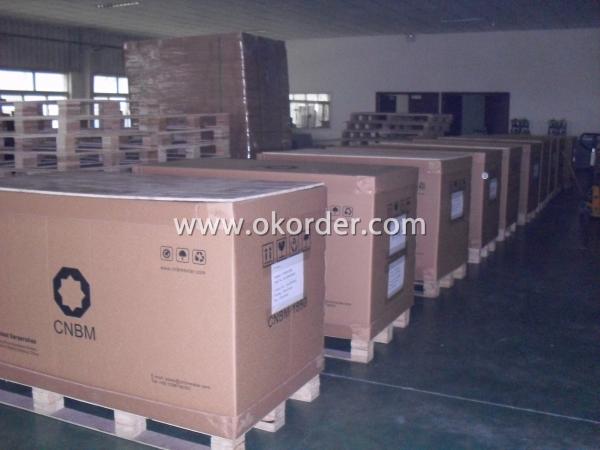
- Q:Can solar panels be installed on south-facing windows?
- Yes, solar panels can be installed on south-facing windows. South-facing windows receive the most sunlight throughout the day, making them an ideal location for solar panel installation.
- Q:I have a solar panel that puts out 00v, .5 amps in full sun. Before I thought it would charge a 2v battery without a solar charger but then I talked to someone and they said that it was wasting a lot of power and could potentially hurt the battery. A second part to this question is what happens if I put it on a 72v battery without a controller. Thanks!
- yes not good.. why would put 00volts to a 2 volt battery? the best you can hope for is to destoy the battery 3.6v max do not excide max amp on battery
- Q:im trying to experiment with solar panels. so i dont want to buy a huge expensive solar panel if i dont need one.
- They are powered from internal batteries, so what you really want to do is to charge the batteries. Take them one at a time, as they have different power and voltage requirements. Don't try to do them both together, unless you use an inverter. To directly charge a battery from a solar panel, you need to find out the voltage and current requirements for the charge operation. Then find a solar panel with a voltage somewhat higher. the current can be lower, it will just take longer for the charge. You will have to monitor manually the state of charge of the battery(s) to avoid overcharging and damage. Another alternative is to get a solar panel that will supply 2 volts and use that to operate an inverter that will output 20 VAC with AC sockets on it. then you can plug in the battery chargers that you have, and they will handle the batteries correctly. Or you can buy solar panels with built in circuitry to handle the charge control. .
- Q:Can solar panels be installed on universities or educational campuses?
- Yes, solar panels can be installed on universities or educational campuses. In fact, many educational institutions around the world have already embraced solar energy as a sustainable and renewable source of power. Installing solar panels on universities and educational campuses not only helps reduce carbon emissions and dependence on fossil fuels but also provides valuable hands-on learning opportunities for students studying renewable energy and sustainability. Additionally, solar panels can help universities save on energy costs in the long run, allowing them to allocate more resources to other educational initiatives.
- Q:What is the impact of dust and dirt on solar panels' efficiency?
- Dust and dirt can significantly impact the efficiency of solar panels. When a layer of dust accumulates on the surface of the panels, it reduces the amount of sunlight reaching the solar cells, thereby reducing their ability to convert sunlight into electricity. This decrease in efficiency can range from a few percentage points to even as much as 20% in extreme cases. Therefore, regular cleaning and maintenance of solar panels are essential to maintain their optimal performance and maximize energy production.
- Q:i need as many bad things there is about solar panels
- . Expen$ive. 2. Must be large to generate much useful energy 3. Don't work in the dark 4. Lose efficiency if not kept clean 5. Lose efficiency in less than full sunlight 6. STILL don't satisfy the tree huggers...they delayed a solar panel farm out west for years to wait on an environmental impact study of the land beneath the panels.
- Q:Can solar panels be used in areas with frequent lightning storms?
- Yes, solar panels can be used in areas with frequent lightning storms. However, it is important to install proper lightning protection measures to ensure the safety of the solar panel system. This may include grounding the panels and using surge protectors or lightning arresters to divert the electrical charge from lightning strikes.
- Q:So how does a solar panel work? Where does the energy get stored in? How much does one cost for a small 2 family home? How much money would we save on electricity?
- it all depends on how much electricity you use for heating/cooling and cooking.......if you just need lights, TVs etc then you could get away with about $5-8,000 US for a system depending on how far north you live.....to go completely off the grid is near $25,000 by the time batteries and inverters and all of that is figured in....
- Q:Has anyone actually used those kits online like energy4green or earth4energy to build their own solar panels or windmills? I'm so tempted but with my budget can't afford to waste any money. They have a 60 day money back policy but that doesn't include the money used to buy the supplies to try and build the things. My electric bill is almost $300 a month due to my stay at home disabled veteran husband who went from Utah snow to Florida sun and he has to have the AC on really cold. If anyone has actually built one can you tell me of your experience and if it actually is worth the money? I do lots of D.I.Y. projects but am a novice with electric besides installing a ceiling fan and changing out a light switch.
- All okorder
- Q:Can solar panels be damaged by hail or other flying debris?
- Yes, solar panels can be damaged by hail or other flying debris. Hailstones, especially those larger in size, can potentially crack or shatter the glass surface of solar panels, impairing their function. Similarly, flying debris during storms or extreme weather conditions can also cause physical damage to solar panels, affecting their efficiency and performance. To mitigate these risks, solar panels are designed to withstand certain levels of impact, and some manufacturers even conduct rigorous testing to ensure their durability in harsh conditions.
1. Manufacturer Overview |
|
|---|---|
| Location | Jiangsu, China |
| Year Established | 2004 |
| Annual Output Value | Below US$1 Million |
| Main Markets | Australia;Asia;South East Asia; South America;North America; Europe;Africa |
| Company Certifications | ISO 9001:2008; CE; TUV; UL |
2. Manufacturer Certificates |
|
|---|---|
| a) Certification Name | |
| Range | |
| Reference | |
| Validity Period | |
3. Manufacturer Capability |
|
|---|---|
| a)Trade Capacity | |
| Nearest Port | Shanghai |
| Export Percentage | 1% - 10% |
| No.of Employees in Trade Department | 200-300 People |
| Language Spoken: | English;Chinese |
| b)Factory Information | |
| Factory Size: | Above 8,000 Square meter |
| No. of Production Lines | 6 |
| Contract Manufacturing | OEM Service Offered;Design Service Offered |
| Product Price Range | Average |
Send your message to us
Poly Solar Panels CNBM (250W-260W)
- Loading Port:
- China Main Port
- Payment Terms:
- TT or LC
- Min Order Qty:
- 1 pc watt
- Supply Capability:
- 10000 pcs per month watt/month
OKorder Service Pledge
OKorder Financial Service
Similar products
New products
Hot products
Hot Searches
Related keywords

